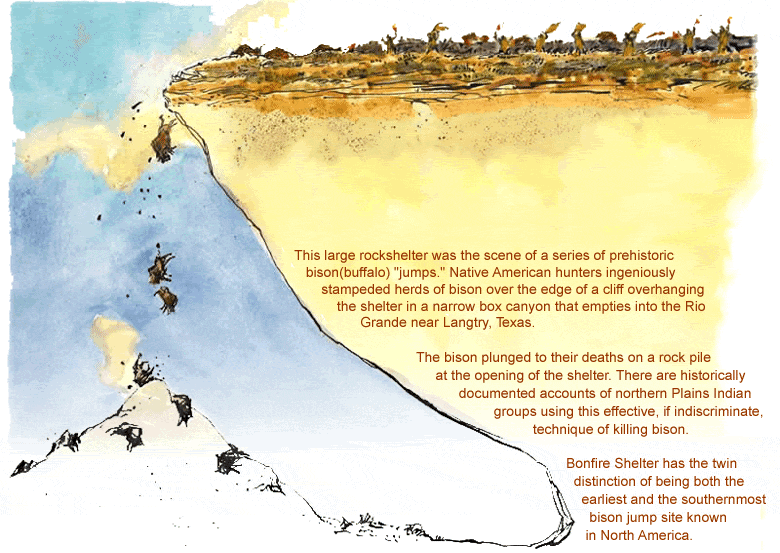
The first definitive jump episodes at Bonfire Shelter occurred over 11,700 years ago (9700 B.C. or earlier) during the Paleoindian era at the end of the last Ice Age (Pleistocene). At least three separate events created what archeologists call Bone Bed 2, a layer in the shelter's deposits containing the bones of a now-extinct species of buffalo (Bison bison antiquus or B. bison occidentalis) as well as a small number of stone tools including Folsom and Plainview projectile points.
Almost 8,000 years later (about 800 B.C.), Late Archaic hunters succeeded on at least one occasion in driving hundreds of modern bison (Bison bison) off the same cliff and into Bonfire shelter, forming the massive deposit known as Bone Bed 3. The specialist who studied the bones argued that Bone Bed 3 represents a single, extraordinary event during which as many as 800 bison, almost all cows and yearling calves, plunged to their deaths. The Late Archaic hunters killed many more bison than they could make use of and left behind a rotting heap of partially butchered bison carcasses. The decaying mass built up heat and gasses until it spontaneously combusted in an intense blaze that reduced most of the bison bones to ash. It was this bonfire that gives the shelter its name. Bone Bed 3, the thick deposit of burned bone left by the bonfire, yielded broad triangular dart points as well as other stone tools used to butcher the bison.
Archeologists from The University of Texas at Austin partially excavated Bonfire Shelter in 1963-64 during the extensive research that preceded the construction of the nearby Amistad Reservoir. Twenty years later, in 1983-1984, another group of archeologists from UT Austin returned to Bonfire to further investigate deeply buried bone bed deposits containing the remains of now-extinct Pleistocene mammals including horse, bison, camel, mammoth, and antelope. The investigators found five separate layers of bone below the two layers of bone termed Bone Bed 1 by the original excavators. The earliest bone deposits at Bonfire date to over 14,100 years ago (before 12,100 B.C.). It is not certain that humans were involved in the deaths and dismemberments of the animals in the lower Bone Beds. No stone tools were found, but both groups of archeologists hypothesized that humans were involved in the deaths of some of these animals based on bone breakage patterns and other evidence.
Exploring the Bonfire Web Pages
To find out more about Bonfire Shelter, click on any of the navigational buttons at the top and bottom of this page. For a proper introduction to the site, you might want to start with "The Land and its Caretakers" followed by "Explore Bonfire" and then "Investigations."